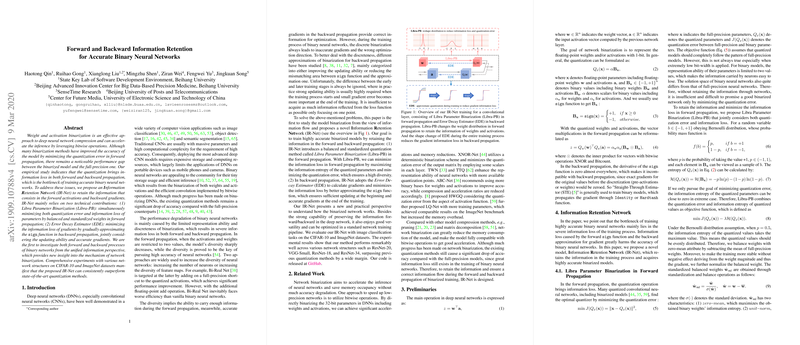Overview of "Forward and Backward Information Retention for Accurate Binary Neural Networks"
The paper "Forward and Backward Information Retention for Accurate Binary Neural Networks," authored by Haotong Qin, Ruihao Gong, Xianglong Liu, Mingzhu Shen, Ziran Wei, Fengwei Yu, and Jingkuan Song, presents an innovative approach to enhancing the performance of binary neural networks (BNNs) by reducing information loss in both forward and backward propagation. The authors introduce the Information Retention Network (IR-Net), which leverages two key techniques: Libra Parameter Binarization (Libra-PB) and the Error Decay Estimator (EDE). These methods together aim to address the accuracy drop that often occurs with binarized versions of deep neural networks (DNNs) compared to their full-precision counterparts.
Binary Neural Networks: Challenges and Innovations
Binary Neural Networks are particularly attractive due to their low storage requirements and efficient inference, relying on bitwise operations. Despite their efficiency, they typically suffer from a significant performance gap relative to full-precision models due to the limitations inherent in quantizing weights and activations, which leads to information loss. The traditional quantization methods generally minimize quantization error without adequately addressing the broader issue of information loss throughout the training process.
Libra Parameter Binarization (Libra-PB)
The Libra Parameter Binarization technique is a novel approach in the forward propagation of BNNs, designed to minimize both quantization error and information loss by transforming weight distributions. This involves balancing the network weights to achieve a zero-mean distribution, which maximizes the information entropy and diversity. By maximizing the entropy, Libra-PB ensures the binary representations of weights and activations carry more significant information, thereby reducing the potential performance drop. Moreover, the introduction of an integer bit-shift scale allows for enhanced representation capability without incurring additional floating-point computational cost.
Error Decay Estimator (EDE)
To further mitigate the limitations of binary networks, the Error Decay Estimator is integrated into the backward propagation process. Unlike typical approaches that either focus solely on updating capability or gradient precision, EDE dynamically adjusts the training process according to specific stages. In the early training stages, it maintains update potential by keeping derivatives close to one, gradually shifting towards precise gradients near the training's end. This method successfully balances the trade-off between strong update potential and low gradient error throughout the training, thereby retaining optimization accuracy.
Experimental Validation and Implications
The efficacy of the IR-Net is rigorously validated across various network structures such as ResNet-20, VGG-Small, ResNet-18, and ResNet-34, using CIFAR-10 and ImageNet datasets. The results indicate that IR-Net consistently outperforms existing state-of-the-art quantization approaches, closing the performance gap between binary and full-precision models significantly. This improvement highlights the feasibility of BNNs in environments requiring reduced computational overhead without sacrificing accuracy.
Future Perspectives
The advancements demonstrated by IR-Net underscore its potential applications in areas demanding efficient neural networks, particularly on resource-constrained devices such as mobile phones and IoT devices. Future exploration could involve refining the techniques of Libra-PB and EDE to further enhance efficiency, or extending them to more complex neural network architectures beyond standard CNNs. Additionally, integrating these approaches with other neural network optimization techniques could unlock even greater performance levels, paving the way for broader adoption of BNNs in practical applications.
In summary, the introduction of IR-Net presents a substantial step forward in the field of model binarization, promising more accurate and resource-efficient neural networks. The methodologies outlined within this paper not only advance current scientific understanding but also expand practical horizons for deploying machine learning models in real-world scenarios.
